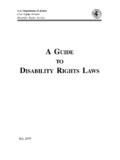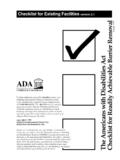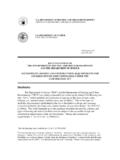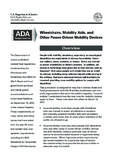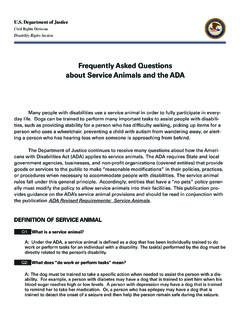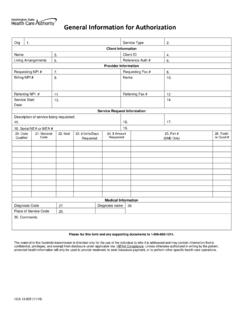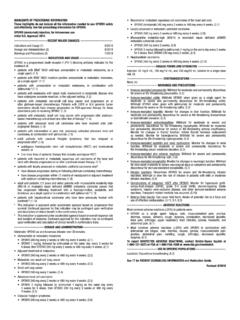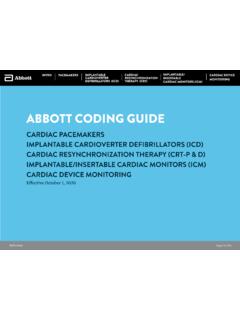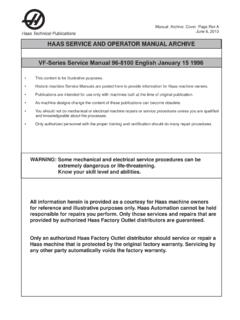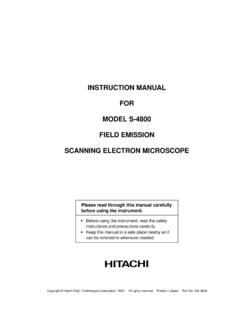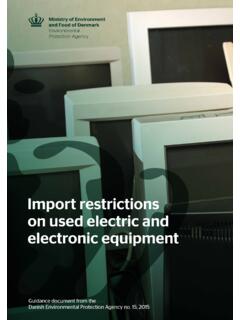Transcription of Checklist for Existing Facilities version 2 - ADA
1 COMPLIANCE MATERIALST I T L E S I I & I I IADA Checklist for Existing Facilities version obtain additional copies of this Checklist , contact yourDisability and Business Technical Assistance be automaticallly connected to your regional center,call 1-800-949-4 ADA. This Checklist may be copied asmany times as desired by the Disability and BusinessTechnical Assistance Centers for distribution to smallbusinesses but may not be reproduced in whole or in partand sold by any other entity without written permission ofAdaptive Environments, the 1995 Adaptive Environments Center, Free Environments, Free Environments, Inc. and Adaptive EnvironmentsCenter, Inc. are authorized by the National Institute on Disabilityand Rehabilitation Research (NIDRR) to develop information andmaterials on the Americans with Disabilities Act (ADA). However,you should be aware that NIDRR is not responsible for enforcementof the ADA.
2 The information, presented here is intended solely asinformal guidance, and is neither a determination of your legalrights or responsibilities under the Act, nor binding on any agencywith enforcement responsibility under the Americans with Disabilities ActChecklist for Readily Achievable Barrier RemovalAugust 1995 COMPLIANCE MATERIALSTITLEIIIADAThe goal of the survey process is to plan how tomake an Existing facility more usable for peoplewith disabilities. The Department of Justice (DOJ)recommends the development of an Implementa-tion Plan, specifying what improvements you willmake to remove barriers and when each solutionwill be carried out: ..Such a serve asevidence of a good faith effort to Technical RequirementsThis Checklist details some of the requirementsfound in the ADA Standards for AccessibleDesign (Standards). The ADA AccessibilityGuidelines (ADAAG), when adopted by DOJ,became the Standards.
3 The Standards are part ofthe Department of Justice Title III Regulations,28 CFR Part 36 (Nondiscrimination on the basis Final Rule). Section of this regu-lation, which covers barrier removal, should bereviewed before this survey is , keep in mind that full compliance withthe Standards is required only for new construc-tion and alterations. The requirements are pre-sented here as a guide to help you determine whatmay be readily achievable barrier removal for ex-isting Facilities . The Standards should befollowed for all barrier removal unless doing sois not readily achievable. If complying with theStandards is not readily achievable, you mayundertake a modification that does not fully com-ply, as long as it poses no health or safety addition to the technical specifications, eachitem has a scoping provision, which can be foundunder Section in the Standards. This sectionclarifies when access is required and what theexceptions may state has its own regulations regardingaccessibility.
4 To ensure compliance with all codes,know your state and local codes and use the morestringent technical requirement for every modifi-cation you make; that is, the requirement thatprovides greater access for individuals withdisabilities. The barrier removal requirement forexisting Facilities is new under the ADA andsupersedes less stringent local or state for Existing Facilities version for Existing Facilities version revised August 1995, Adaptive Environments Center, Inc. for the National Institute onDisability and Rehabilitation Research. For technical assistance, call 1-800-949-4 ADA (voice/TDD).2 IntroductionTitle III of the Americans with Disabilities Actrequires public accommodations to provide goodsand services to people with disabilities on an equalbasis with the rest of the general public. The goal isto afford every individual the opportunity to benefitfrom our country s businesses and services, and toafford our businesses and services the opportunityto benefit from the patronage of all regulations require that architectural andcommunication barriers that are structural mustbe removed in public areas of Existing facilitieswhen their removal is readily achievable inother words, easily accomplished and able to becarried out without much difficulty or accommodations that must meet thebarrier removal requirement include a broadrange of establishments (both for-profit andnonprofit) such as hotels, restaurants, theaters,museums, retail stores, private schools, banks,doctors offices, and other places that serve thepublic.
5 People who own, lease, lease out, oroperate places of public accommodation inexisting buildings are responsible for complyingwith the barrier removal removal of barriers can often be achieved bymaking simple changes to the physical , the regulations do not define exactly howmuch effort and expense are required for a facility tomeet its obligation. This judgment must be madeon a case-by-case basis, taking into considerationsuch factors as the size, type, and overall financialresources of the facility, and the nature and cost ofthe access improvements needed. These factors aredescribed in more detail in the ADA regulationsissued by the Department of process of determining what changes arereadily achievable is not a one-time effort; accessshould be re-evaluated annually. Barrier removalthat might be difficult to carry out now may bereadily achievable later. Tax incentives are avail-able to help absorb costs over several of This ChecklistThis Checklist will help you identify accessibilityproblems and solutions in Existing Facilities inorder to meet your obligations under the This Checklist is NotThis Checklist does not cover all of the requirementsof the Standards; therefore, it is not for facilitiesundergoing new construction or alterations.
6 In ad-dition, it does not attempt to illustrate all possiblebarriers or propose all possible barrier removalsolutions. The Standards should be consulted forguidance in situations not covered Title III regulation covers more than barrier re-moval, but this Checklist does not cover Title III srequirements for nondiscriminatory policies andpractices and for the provision of auxiliary commu-nication aids and services. The communication fea-tures covered are those that are structural in Checklist is based on the four priorities recom-mended by the Title III regulations for planningreadily achievable barrier removal projects:Priority 1: Accessible approach and entrancePriority 2: Access to goods and servicesPriority 3: Access to rest roomsPriority 4: Any other measures necessaryNote that the references to ADAAG throughout thechecklist refer to the Standards for Accessible to Use This Checklist3 Get Organized: Establish a time frame for com-pleting the survey.
7 Determine how many copies ofthe Checklist you will need to survey the wholefacility. Decide who will conduct the survey. It isstrongly recommended that you invite two or threeadditional people, including people with variousdisabilities and accessibility expertise, to assist inidentifying barriers, developing solutions forremoving these barriers, and setting priorities forimplementing Floor Plans: It is very helpful to havethe building floor plans with you while you plans are not available, use graph paper to sketchthe layout of all interior and exterior spaces used byyour organization. Make notes on the sketch or planwhile you are the Survey: Bring copies of this check-list, a clipboard, a pencil or pen, and a flexible steelChecklist for Existing Facilities version revised August 1995, Adaptive Environments Center, Inc. for the National Institute onDisability and Rehabilitation Research.
8 For technical assistance, call 1-800-949-4 ADA (voice/TDD).3tape measure. With three people surveying, oneperson numbers key items on the floor plan tomatch with the field notes, taken by a second per-son, while the third takes measurements. Be sure torecord all dimensions! As a reminder, questionsthat require a dimension to be measured andrecorded are marked with the ruler about each space from the perspective ofpeople with physical, hearing, visual, and cognitivedisabilities, noting areas that need Barriers and Solutions: List barriersfound and ideas for their removal. Consider the solutions listed beside each question, and add yourown ideas. Consult with building contractors andequipment suppliers to estimate the costs for mak-ing the proposed Decisions and Set Priorities: Reviewthe summary with decision makers and which solutions will best eliminate barriersat a reasonable cost.
9 Prioritize the items you decideupon and make a timeline for carrying them the removal of barriers is not readily achiev-able, you must consider whether there are alterna-tive methods for providing access that are Documentation: Keep your survey,notes, summary, record of work completed, andplans for alternative methods on Changes: Implement changes as refer directly to the Standards and yourstate and local codes for complete technical require-ments before making any access improvement. Ref-erences to the applicable sections of the Standardsare listed at the beginning of each group of ques-tions. If you need help understanding the federal,state, or local requirements, contact your Disabilityand Business Technical Assistance Up: Review your ImplementationPlan each year to re-evaluate whether moreimprovements have become readily obtain a copy of the Title III regulations andthe Standards or other technical information,call the Dept.
10 Of Justice ADA InformationLine at (800) 514-0301 Voice, (202) 514-0381 TDD,or (800) 514-0383 TDD. For questions aboutADAAG, contact the Architectural andTransportation Barriers Compliance Boardat (800) USA-ABLE. QUESTIONS POSSIBLE SOLUTIONSC hecklist for Existing Facilities version revised August 1995, Adaptive Environments Center, Inc. for the National Institute onDisability and Rehabilitation Research. For technical assistance, call 1-800-949-4 ADA (voice/TDD).4 Add a ramp if the route oftravel is interrupted by an alternative route onlevel uneven small bumps and breakswith beveled gravel with hard or move landscaping,furnishings, or other featuresthat narrow the route of or remove a cane-detectable base thatextends to the a cane-detectable object onthe ground underneath as awarning curb small ramp up to ramp to available space is limited,reconfigure ramp to Nowidthdistancefrom wall/heightslopeAccessible Approach/EntrancePeople with disabilities should be able toarrive on the site, approach the building,and enter as freely as everyone else.
